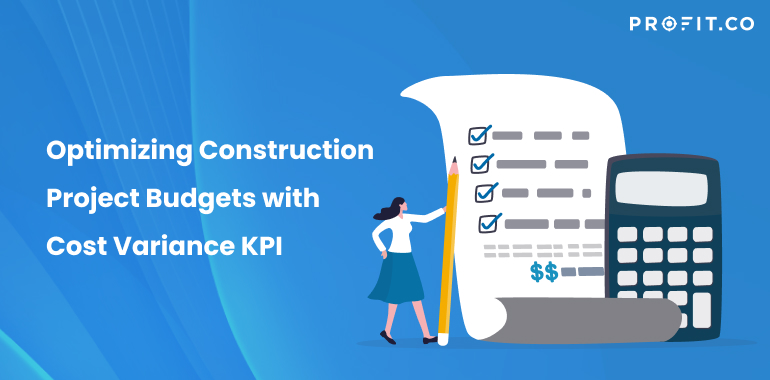In the fast-paced world of construction project management, staying on budget is crucial. That’s where cost variance (CV) comes in as your trusty financial compass guiding project managers in tracking deviations between the actual expenditures and the planned budget. It’s a key performance indicator (KPI) that helps you track how much your project’s actual costs deviate from your planned budget so you can identify future problems and make corrections before they derail your project.
The Cornerstone of Construction Management
Effective financial management in construction projects is one of the toughest but crucial indicators of success. Unforeseen issues or scope changes can quickly spiral, leading to cost overruns that threaten project viability and profitability. Recognizing this criticality, Cost Variance (CV) emerges as a critical Key Performance Indicator (KPI), offering a clear and objective picture of a project’s financial health against its allocated budget.
Understanding Cost Variance CV)
CV, a specialized metric for the construction industry, measures the financial performance of a project by meticulously comparing the budgeted cost of completed work with the actual expenses incurred.
By utilizing the formula CV = Earned Value (EV) – Actual Cost (AC), project managers precisely understand whether the project is adhering to its financial roadmap.
Interpreting CV
- Positive CV (CV > 0): This signifies commendable cost efficiency, indicating the project is under budget.
- Zero CV (CV = 0): Implies meticulous financial planning, with project expenses perfectly aligning with the planned budget.
- Negative CV (CV < 0): Raises a red flag, highlighting areas requiring immediate financial review and potential adjustments.
By interpreting CV effectively, project managers can make informed decisions that ensure financial alignment with budgetary expectations, fostering project sustainability and success.
A Practical Illustration for the construction Industry
Consider a construction project with a budgeted foundation cost of $100,000. If actual spending reaches $120,000, the CV calculation would reveal:
CV = 100,000 – 120,000 = -20,000
A negative CV of -$20,000 indicates the project exceeded its foundation stage budget. This necessitates a thorough financial analysis and prompt adjustments to prevent further overruns, safeguarding project profitability.
Good fortune is what happens when opportunity meets with planning
Optimizing the Value of CV with Some Best Practices
- Integration with Other KPIs: Use CV with metrics like Schedule Variance (SV) and Cost Performance Index (CPI) to better understand project performance.
- Regular Monitoring and Reporting: Continuously track and report CV to identify trends and implement timely corrective actions.
- Root Cause Analysis: Determine the reasons behind significant CV deviations to understand their underlying causes and proactively address them.
- Stakeholder Communication: Foster transparency and collaborative problem-solving by sharing CV insights with stakeholders and team members.
Not sure where to start? Schedule a free session with our OKR experts!
Leveraging CV through OKRs
To fully integrate the concept of optimizing construction costs for enhanced project profitability into our discussion, let’s delve deeper into defining specific, measurable Objectives and Key Results (OKRs) that focus on Cost Variance (CV). Effective OKRs are SMART: Specific, Measurable, Achievable, Relevant, and Time-bound. This approach will provide clarity on our financial targets and outline actionable steps towards achieving them. We’ll present this concept with a practical example that brings the theory to life.
Objective: Optimize Construction Costs for Enhanced Project Profitability
KR1: Achieve a CV from -5% to 0 or higher
Initiatives
- Implement more detailed budget forecasting and planning at the project initiation phase.
- Develop a real-time cost monitoring system to track expenses against the budget continuously.
- Conduct workshops for project managers and financial analysts on identifying and mitigating financial risks.
KR2: Reduce instances of negative CV from 15% to 5% or less
Initiatives:
- Provide training for procurement teams on negotiation strategies.
- Standardize a process for managing change orders.
- Integrate a contingency planning protocol that allocates funds for unforeseen expenses.
KR3: Increase instances of positive CV from 10% to 30%
Initiatives:
- Adopt lean construction methodologies to eliminate waste.
- Implement a performance-based incentive program for teams that achieve or exceed CV targets.
- Engage strategically with suppliers to explore cost-saving opportunities.
Bringing OKRs into Practice: A Real-World Example
Let’s apply these OKRs to a hypothetical construction project – developing a new residential complex. The project’s initial budget projections show a trend towards a -5% CV due to rising material costs and initial estimates not accounting for potential delays or changes in scope.
By implementing the outlined initiatives, such as enhanced budget planning and real-time cost monitoring, the project team can identify financial risks early and adjust procurement strategies accordingly. Training in vendor negotiation and change order management further ensures that any alterations to the project scope are financially viable, aiming to keep the project within or under budget.
Halfway through the project, adopting lean construction practices and performance incentives for the project team leads to increased cost-saving measures being identified and implemented. Strategic supplier collaborations also contribute to this positive shift, allowing the project to purchase materials in bulk at a discounted rate, further improving the CV.
As a result, the residential complex project not only meets its revised CV targets but also demonstrates an improved financial performance, with an increased rate of positive CV instances reflecting under-budget completions. This approach enhances project profitability and builds a framework for financial efficiency and accountability in future construction projects.
Conclusion
While recognizing construction cost variances is crucial, it’s merely the first step toward responsible financial stewardship. It prompts a deeper investigation into spending behaviors and overall project cost-effectiveness. By analyzing the root causes behind cost variances, project managers can strategize on resource allocation, budget adjustments, and project planning optimizations. This forward-thinking approach ensures that construction projects not only adhere to their financial objectives but also contribute positively to the overall fiscal health of the organization.
Ready to start your journey to optimizing your business
Related Articles
-
Understanding Planned Value and Its Importance in Project Management
In project management, monitoring and measuring progress are essential to ensuring that projects stay on track and deliver expected results.... Read more
-
How to Calculate Billable Utilization and Why It Matters for Your Business
Introduction In the professional services world, tracking how much time your employees spend on billable projects is crucial. Billable utilization... Read more
-
What Is Budget Variance? A Simple Guide to Understanding and Managing It
Introduction Have you ever set a budget for something, only to find out later that you spent way more or... Read more
-
Maximize Project Success with a High Project Completion Rate (PCR)
Keeping track of progress and success is essential for any project. Projects need to be completed on time and within... Read more

